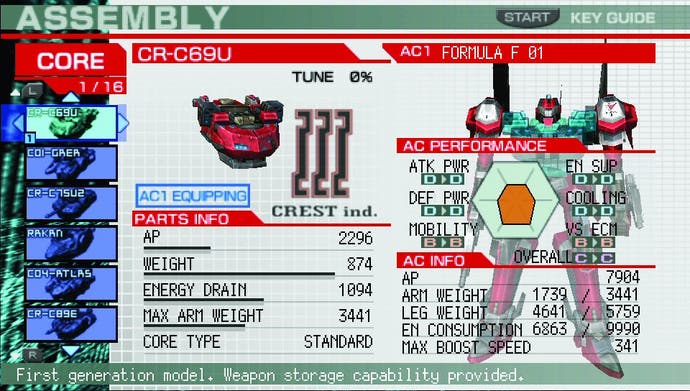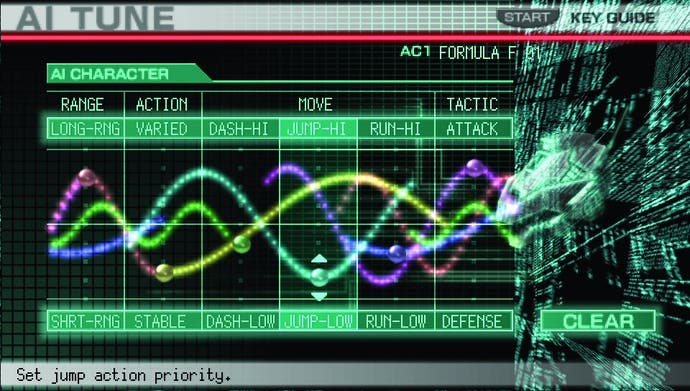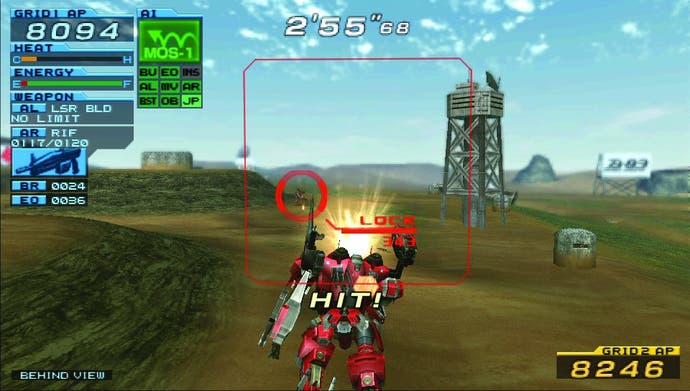Armored Core: Formula Front
Giant robots in the palm of your hand.
There's a distinct point in my childhood when I clearly recall being struck by the realisation that I was, to be blunt, a geek. It wasn't when I tried to convince my family that, like Han Solo, I could understand what Chewbacca was saying. It wasn't even when I spent a weekend with a tape recorder pressed up to the TV, recording a compilation of my favourite ZX Spectrum themes.
No, it was when all my friends were collecting Transformers, that seminal eighties toyline about giant robots in disguise, while I was the only person at my school to have nailed their toy allegiance to the mast of Tomy's Zoids. Like Optimus Prime and gang, Zoids were giant robots but their key selling point was that you had to build the damn things before you could play with them. And even then, you had to be tediously careful, lest their fragile plastic and clockwork frame got snapped during a pitched battle. Needless to say, most sane kids simply couldn't be arsed. Me? Loved it.
I heart robots

Despite this inauspicious start, I somehow grew up into an adult and got a job reviewing PlayStation games. And in 1997 my childhood trauma came thundering back, as I tried - mostly in vain - to spread the gospel of an obscure mech fighting game called Carnage Heart. Like Zoids, this Japanese oddity required you to painstakingly build robot killing machines - including the AI software that would guide them in battle. Then you sat back and watched, as the CPU did all the exciting work of shooting and blowing stuff up.
So you can hopefully imagine the conflicting emotions that raged as I fired up the first portable offering in the Armored Core franchise. Previous console incarnations never really grabbed me, as they mostly seemed to play like rather dreary shoot-'em-ups that used giant robot graphics to excuse a sluggish game engine. This PSP edition is different though - just like Carnage Heart, the aim this time around is to build a better robot, and trust all the explosive stuff to the AI you create.
Well, to be fair, you can also pilot your creations manually (an addition unique to the western release) but the game takes the bold step of openly telling you - during the tutorial missions, no less - that only a complete moron would play the game that way. "Too difficult to control!" it yelps, and it's right. The mech controls are a horror on the PSP's stubby little joystick, and the emphasis is justifiably shunted to the creation side of the equation.
Classy chassis

Cast as the boss of a new team in the Robot Jox-style futuristic spectator sport of Formula Front, you have five Armored Cores to tinker with, and a bewildering array of gadgets, gizmos and weapons to choose from. Unlike other games of this ilk, there's a huge amount of things to play with right from the start, and no need to pay for any of it. In other words, it's a Make Your Own Mech sandbox, and if you're that way inclined (you geek) you'll probably spend an hour or so just mucking about with different designs.
Weight is an issue, with the legs and chassis needing to support everything you plan on bolting on. Energy and heat control are also key, as the more sophisticated the equipment, the more cooling and distribution it needs to keep everything working smoothly. It's a balancing act, basically, between what you want and what you can actually do. Then you slap on a load of missile launchers, energy beams, machine guns, radar arrays and ECM jamming systems.
Inevitably, you create something that looks really cool, bristling with awesome firepower and probably christened with a cheesily macho codename like Onyx Wraith. Then you try it out in combat and it gets its shiny metal ass well and truly hammered. Because, in your rush to live out your Gundam fantasies, you forgot to give it some brains.
The AI is configured in three ways - basic behaviour can be set by choosing a balance between settings such as long range vs. short range and all-out attack vs. cautious defence. These can then be enhanced by using the available processing space in your Core's head to define how efficient your creation will be at, say, locating the enemy, navigating the terrain or choosing the best weapon for the situation. A third and final layer of AI comes in the form of microchips that trigger specific actions at specific times. So you can force your Core to move in at the start of the battle, hammer away with bladed weapons before strafing away using machine guns and finishing off with long-range missile strikes.
Mech my day

Thankfully, the effects of these tweaks can be seen quite clearly in the performance of your Core, though there are still annoying instances where your carefully constructed machine decides to fire precious ammo into thin air, stands next to the enemy without attacking or just jumps around for no apparent reason. Even so, despite the overwhelming amount of info hurled at you from the tiny PSP screen, patience and perseverance pays off with a game that is deceptively easy to get into and reasonably rewarding, if you make the effort.
Ultimately though, Formula Front's long term appeal is hampered by several factors. The sandbox approach to Core creation makes for an appealing start to the game, but it gives you very little to aim for. New AI chips are sporadically added to your stash, but they're often of dubious use while the weapons and systems options grow stale quite fast. It doesn't help that components are given meaningless names like I043-SQUID, and precious little in-game explanation, so successful combinations are more likely to come through trial and error than skill.
This free-for-all style also means that there's no financial cost to any of your remodelling and rebuilding, so you can just use the same machine over and over until you find a combination that works. As a result, by the time you finish the handful of training matches, you'll find you've got one Core that can waltz through most conflicts without much trouble. You don't even have to repair the damn things, so you can keep throwing them into scraps without worrying about the price of losing.
What you end up with is thirty battles masquerading as a fairly rigid sports league, in which you can try each fight as many times as you like, using whatever weaponry you want. It's fun to start with, and Mech fans will still want to give it a spin. Certainly the decision to favour strategy over blasting makes for an intriguing diversion to start with, but the reams of statistics mask a disappointingly simplistic game. All told, it's hardly a riveting challenge and you'll have seen most of what the game has to offer in a weekend. Fellow mechphiles shouldn't feel too deflated though - a PSP version of Carnage Heart is in the pipeline...

